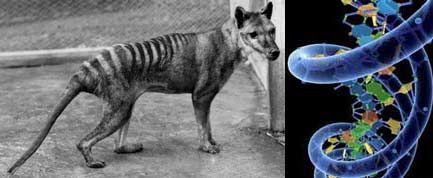Extinct Tasmanian Tiger's DNA Revived in Mice

DNA from an extinct creature has been resurrected in a live animal for the first time. The genetic material, extracted from the extinct Tasmanian tiger, proved functional in mice. "As more and more species of animals become extinct, we are continuing to lose critical knowledge of gene function and their potential," said researcher Andrew Pask, a molecular biologist at the University of Melbourne in Australia. Reviving genes from extinct animals can't bring them back to life, but it could help retrieve this potentially valuable knowledge. "This research has enormous potential for many applications including the development of new biomedicines and gaining a better understanding of the biology of extinct animals," said researcher Richard Behringer at the University of Texas. And while the Tasmanian tiger has only been extinct for roughly 70 years, "the potential this method has for examining genes from much older specimens, in fact anything with some intact DNA, is very exciting," said researcher Marilyn Renfree, a reproductive and developmental biologist at the University of Melbourne. Hunted to extinction The last known Tasmanian tiger, or thylacine, died in captivity in 1936 in the Hobart Zoo in Tasmania. This enigmatic marsupial carnivore was hunted to extinction in the wild in the early 1900s. "I have worked on marsupials for my whole career, and have always had a secret hope that the thylacine wasn't really extinct," Renfree said. "It was Australia's top carnivore still living when Europeans first came to this country, and we quickly hunted it to extinction." In fact, a study last year hinted at the possibility that the creatures might still exist, but the evidence was not conclusive. Fortunately, some thylacine young were preserved in alcohol in several museum collections around the world, as were tissues from adults, such as in pelts. The international team of scientists isolated DNA from 100-year-old thylacine specimens at Museum Victoria in Melbourne. Next this genetic material was inserted into mouse embryos and investigated for how it functioned. The researchers found a snippet of thylacine DNA could, like its mouse counterpart, regulate the gene Col2a1, which is key to the embryonic development of cartilage that later forms bone. Scientists have previously isolated DNA from extinct species ranging from bacteria and plants to mammoths and Neanderthals. Until now, such genetic material had at most been "plugged into" cells grown on dishes in labs, and it had not been possible to examine what role the DNA played in development. "Examining function in whole embryos enables us to determine when genes are turned on and off and in which cell types and organs, so that we can accurately assess gene function," Renfree explained. To put the finding into perspective, consider that the vast majority of species that have ever lived on this planet are now extinct. "Extant species — those alive on the planet today — represent less than 1 percent of the total biodiversity that has ever existed," Pask explained. "For those species that have already become extinct, our method shows that access to their genetic biodiversity may not be completely lost." Especially useful now This research might prove especially helpful now, "at a time when extinction rates are increasing at an alarming rate, especially of mammals," Renfree added. This approach does have its limitations. "Some genes are required to interact with multiple other proteins and receptors in order to show a function," Pask said. "In these cases, unless the host organism, in this case the mouse, has a compatible set of other proteins and receptors we would be unable to examine the function of these genes." And such an experiment should not suggest "that this is an answer to extinction or that it is OK for an animal to go extinct because we can still preserve their genomes," Renfree cautioned. "This method is able to examine one or a few genes from an extinct species at a time, but this particular method would never be able to bring an animal back from extinction. Our method just enables us to examine the function of those genes already lost." The scientists will detail their findings online May 21 in the journal PLoS ONE. They were supported by grants from the National Science Foundation and the National Institutes of Health, and by the Ben F. Love Endowment, the ARC Federation Fellowship and the NHMRC C.J. Martin and R. Douglas Wright Research Fellowships.
- Rumor or Reality: The Creatures of Cryptozoology
- Image Gallery: The World's Biggest Beasts
- Top 10 Species Success Stories
Sign up for the Live Science daily newsletter now
Get the world’s most fascinating discoveries delivered straight to your inbox.












